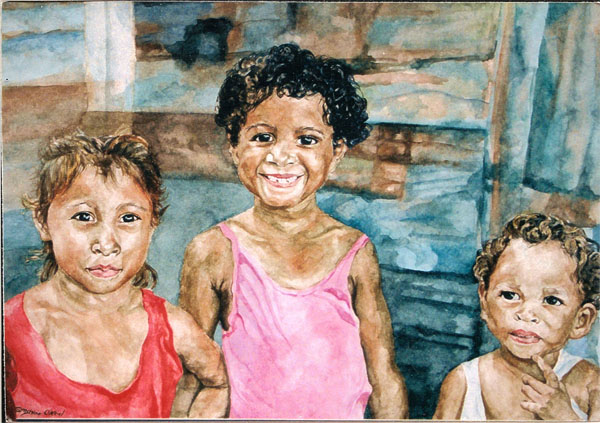
|
◄ A painting of three children by Sol Levantado of Playa Negra, Costa Rica. I see a bit of the Tico soul in each of the three children's expressions, don't you (like, left to right, #1 - wonderment with a little bedevilment (very Tico), #2 unconditional acceptance and #3 bewilderment)?
▼ Yow!, what an angry crab. Wait, that's no crab, that's a Costa Rican flower. But don't ask me what it's name is - Crabiosis Maximus perhaps.
|
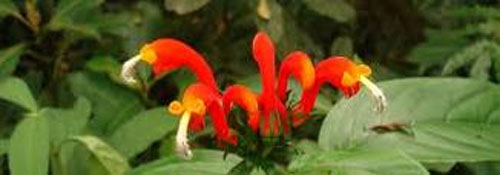 |
IN THIS ISSUE: Broken News (Municipal Elections, Nica Invasion Update), Don't Take Any Wooden Colones,
How Not to Look and Act Like a Tourist,
What's-in-a-Word (Mata Something), ROMEO Corner (Kapi Kapi) |
Broken News
Municipal Elections
Every four years In Costa Rica, municipal elections are held country wide on one day. This year they were held on Sunday, December 5.
The Canton is the principal electoral geographical unit and is similar to a U.S. county. There are over 80 cantons in the country. Cantons can include more than one community. For example, our Canton is called Aguirre and includes the town of Par rita about 20 kilometers north of Quepos as well as some rural areas surrounding us. Parrita was one of the towns hardest hit in the latest round of heavy storms, with over 500 people displaced by flooding from the Rio Parrita (my guess is there are not more than 3,000 people in the town). The administrative office for the Municipality of Aguirre is located in Quepos near the Monge Memorial Bridge (MORE) .
Each Canton elects a mayor (called an acalde, unless you're a lady and then you're an alcadeza) and two vice-mayors (vice-acaldes or vice-alcaldezas). The three candidates run as a ticket under one party label in much the same fashion as the U.S. presidential elections. The term of service is normally four years but I've heard that this particular term will be five years to put the municipal election year out of sync with the presidential election year. The presidential election occurred only a few months ago when Laura Chinchilla, La Presidenta was elected. I'm sure the parties were in favor of this change to offset the timing so that the funding needs for both elections are spread out.
I watched this election with particular interest because my landlady was running for vice-alcaldeza under the United Socialist Christian banner (#20 below). Her picture is below right. I had a campaign poster on my door for three months. Señora Yadira Segura is a remarkable person. She's a mother of three good football players (and excellent students) aged 12-22 years, is a teacher and holds a full time position as a consultant to teachers in the Canton. She also manages the seven apartments in our complex and, if that isn't enough, owns and operates a commercial fishing boat (she doesn't personally do the fishing, there is a captain). Every now and then I get a plate of fresh mahi-mahi filets - yummers.
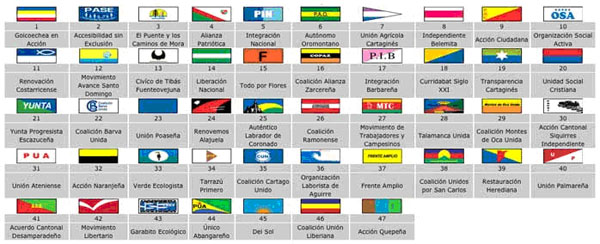
| One of the more interesting aspects of these elections is the number of parties that are involved. In this year's elections there were 47 according to the table above that was published in a local paper. I'm told that a number of these parties are local and formed only to run the municipal elections. People run around with a flag of their party flying from their car throughout the campaign |
|
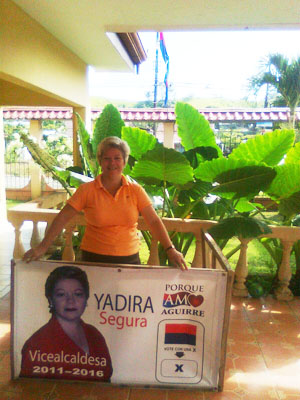
La Candidata Yadira Tearing Down Her Campaign Signs |
|
Unfortunately Señora's team did not win in Aguirre. The new mayor's name is Lutgardo who's party is PLN (#14 above). PLN is one of the strongest, best financed parties in Costa Rica and also happens to be La Presidenta Laura's party. Lutgardo will be taking office, along with his vice-acaIdes, February 5. I suspect Lutgardo will be more careful with the town's cameras than was his predecessor (MORE).
I told Señora Segura that I didn't understand the unsatisfactory result she had in Quepos because, as promised, in the spirit of Chicago politics and according to good Acorn training, I voted for her three times. She just looked at me quizzically, once more wondering if the old dude was one step closer to being put out to the monkey farm.
Nica Invasion Update
The Chronicles reported last month on the Nicaraguan aggression along Costa Rica's northeastern border (more: Invasion). We (I just love using the royal "we") also reported one theory that the objective was to create a new river mouth as a prelude to building a Panama-type canal. Another idea that popped up this month was the possibility that construction of a new port in the disputed region, suitable for cruise ships, could be combined with a new airport planned for southeastern Nicaragua to give a big boost to tourism in Nicaragua, possibly diverting some visitors from Costa Rica to Nicaragua.
Señor Ortega and the Nicaraguan government might try to understand that ultimately it's not the infrastructure that builds tourist and ex-patriot attraction like has been done in Costa Rica, but rather it's the investment climate as well as the ambiance and friendliness of the natives towards outsiders that builds success. Chopping off a piece of your neighbor's yard by force is not a good example of friendliness. Likewise, linking yourself to Hugo Chavez' star does not build confidence in Nicaragua as an investment opportunity.
Unfortunately, at this writing it looks like the aggression will succeed and the land will not be returned to Costa Rica.
Don't Take Any Wooden Colones
One of the first things a visitor or tourist has to deal with when coming to Costa Rica is handling the money. The unit of currency here is the colon or colone, not to be confused with the human internal part of the same name. A word of caution; a Google search for photos of colones also produced many links for colon cleansing techniques including one showing the "end product" of the treatment - muy gross, amigo, muy gross).
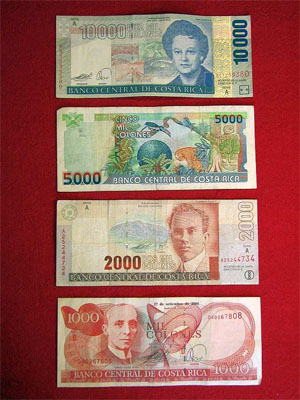
Most Common Denominations of Colones
(from top): 10,000, 5,000, 2,000, 1,000.
Not Shown are the New 20,000 and 50,000 Blls. |
|
Colon is a common name widely used in latino countries. It originates with the explorer Cristobal Colón, who is better known in Rio Linda as Christopher Columbus. The currency colon is also not pronounced like the organ (co-lun), but instead as co-loan with the empahasis on the second syllable. More typically it's co-lo-knee.
For paper colones, there are four denominations widely in use, the 1,000; 2,000; 5,000 and 10,000 notes. Common coins in circulation are 5, 10, 25, 50, 100 and 500 colones. Five and ten colone coins may be either brass-looking or aluminum. Both the bills and the coins are shown in the pictures to the left. Sometimes there are nicknames for them, such as a "rojo" or "red" for a 1,000 (the ink is red) and "tucano" or "tucan" for a 5,000 (there is a Tucan on the note). I've tried to use "azules" or "blues" for the 10's but usually just get blank stares in return.
Except for the Susan B. Anthony dollar and format updates for security purposes on larger bills, U.S. coins and bills denominations have been stable now for many years. The Ticos, however, are more creative and seem to enjoy making changes on a fairly frequent basis, to wit:
- The government recently introduced 20,000 and 50,000 denomination notes. This is interesting for an area like Quepos where it's often hard to get change for a 10,000, but the ATMs have already begun dispensing 20k notes. So far, I've not seen hide nor hair of the 50k. C'mon amigos, save us country folks the grief and keep the 50's in the central bank.
- At one time, there were oddly shaped (kind of a mildly octagonal design) 5, 10 and 20 colone coins which were taken out of circulation recently. If you were holding some when they stopped circulating, the only thing left for them was to make them into necklaces or fishing lures.
- There was a "commemorative" issue 500 colone coin in circulation for some time with a slightly smaller diameter and different printing . It was first issued in 2000 to celebrate the 50th anniversary of the founding of the BCCR (Banco Central de Costa Rica). It is being eliminated, and we have a short time to make sure they get turned into one of the national banks. After that, their use will be limited to the likes of the octagonal coins.
It should be mentioned that Costa Rican coins are much larger and much heavier that their U.S. counterparts. It becomes somewhat of a game to make sure you don't get stuck with a lot of colone coinage that could cause you to drown if you tried to wade a creek with them in your pocket. Our hero wears an old pair of shorts (mi pantalones favoritos) to the beach that have an elastic waistband that has been overwhelmed several times by too many coins in the pocket. When that happens I just pass it off as if I'm trying to look like a teenager. |
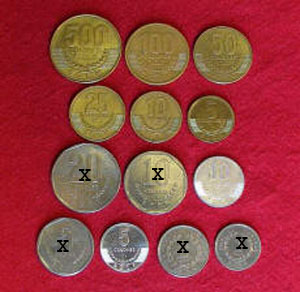
| The Coins marked With an "X" Have Been Eliminated Not Shown is the 500 colone Commemorative Issue. Note 5's and 10's Can Be Either Brass or Aluminum |
|
The current conversion rate (get the latest HERE) is making it easier to relate Colones to Dollars because the rate has recently been hovering around 500 colones to the dollar. So amigos, here's how you make the conversion. To go from colones to dollars, subtract three zeros from the colone denomination and double that number to arrive at dollars. For example, a 10,000 colone bill becomes 10 multiplied by 2 becomes $20. 10,000 colones = $20. Going the other way, divide the dollars by 2 and add three zeros to arrive at colones. For example, $10 is divided by 2 to get 5 and three zeros are added to get 5,000. $10 = 5,000 colones. (Q.E.D. that is, Quod Erat Demonstratum - "that which was to be demonstrated has been" - once a latin student always a latin student)
Using this technique you will not be exact but you will be close. Come back later when the conversion rate will be 537 to the dollar; it'll be much more fun.
How Not to Look and Act Like a Tourist
Our hero lived and grew up on a beach in Massachusetts and didn't leave the area until he was 21. Later, GG lived five minutes from a beautiful beach in Florida that he frequented many times during his 10 years there. For the last two years I have been living near another beautiful beach in Costa Rica. That means I've spent half my life hanging around salt water beach resorts. (My last blood test showed 3% elevated saline)
This experience has meant a lot of exposure to tourists. So I thought I might make an (infinitesimally and dubious) small contribution to beach culture and human harmony if I listed some suggestions on how to improve one's look and behavior as a tourist when visiting our area (or any other tourist area for that matter). To wit:
|
|
|
|
|
|
|
|
|
|
|
|
|
|
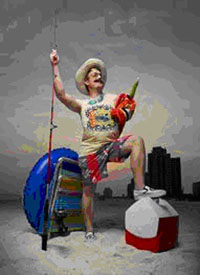
Don't I Look Like a Native? |
|
|
- A definite tourist give away is a skin tone reminiscent of Casper the friendly ghost; call it a Minneapolis tan if you will. Get some sun dude, but start out with a sunscreen or high PSF lotion and work the number down as the days progress; otherwise you're in for the boiled crustacean look. Remember, you're not in Kansas anymore, you're only 9º latitude north of the equator. In comparison, Sarasota, FL is 27º and Minneapolis is 45º, the latter being even farther north than Toronto (brrrrr).
- Long pants are gauche in Tropical climes; most people here wouldn't be caught dead in them. Shorts are de rigeur here amigo, shorts. On the other hand most Josefinos (dudes that live in San José) wouldn't be caught dead in their chilly SJ climate without long pants. But in Quepos/Manuel Antonio, where we're always warm (yuk,yuk), they mark you as different; perhaps as different as a Josefino.
- Ticos wear simple sandals, often just flip-flops. Avoid that special footwear you found at Wal-Mart with a half yard of leather bindings that make a guy look like he's in training to be a gladiator or a women like she's a retired pole dancer. Go light amigo; remember: the ultimate footwear here is no footwear.
- What is it with gringos and large floppy hats? It's like painting a big "G" on your forehead. If you decide to wear one of those things, you might as well go the full monty and put on a short-sleeved, large-flowered, so-bright-it-scares-seagulls-for-miles type shirt. Also, complete your ensemble by adding white socks to go with your gladiator sandals. I call this the full Florida tourist look.
- Nix the mut-luk caps with the ear flaps so popular in Alaska for blizzard-wear as well as the African safari hats. They may do the job of keeping the sun off your ears and bald spot but they look and work best in their respective native habitats; here they immediately tag you as a furriner. Likewise, Che Guevara shirts are not only passé but, pray tell, why the hell would you put a thug and a murderer on your chest - not kool baby, unless you really want to impress drug lords. (More on Che)
- The town I live in is pronounced Kay-pos, not Kway-pos. Get used to it as quickly as possible and you'll avoid both that blank, knowing stare from gringos that live here as well as snide Tico smiles. Likewise it's not Manual Antonio with the "manual" pronounced like it's a car repair book, it's Manuel (mahn-well) Antonio, amigo.
- You can use virtually all types of debit and credit cards here but some types are charged extra by the card issuer and the merchant may require an add-on to the bill to cover it (I've heard of as much as 13%). Debit and credit cards also work well at ATM's (Cajeros Automáticos). Traveler's checks are accepted in most places but are like dial telephones, passé. Debit cards are where the action is amigo (spoken like the old banker GG is). For safety, convenience and speed, don't bring gobs of dollars to exchange and sit in the bank waiting area holding #71 when the electronic sign is posting #27.
- While just about all commercial entities here will accept dollars, dealing in the local currency is easier because (a) change will almost always come in colones whether you tender colones or dollars, (b) the exchange rate used by a merchant may be less favorable than a bank or debit card exchange rate, (c) all the ATM's give colones but only some give dollars and (d) many places will be hesitant to accept $50 bills and some will outright refuse to accept $100 notes (too much fraud going on). Save the dollars for the trip home, you can replenish them at an ATM at the airport on the way out. Most ATM's are now charging a small transaction fee (darn those greedy bankers).
- Most prices are true as posted, this includes trinkets and souvenirs. A flea market vendor (near the beach) or an outdoor market vendor (Fridays and Saturdays at the Quepos bay front), might bargain somewhat but store vendors probably won't. If you have an uncontrolled urge to negotiate price on every purchase you intend to make, please read or re-read "The Ugly American", by Eugene Burdick and William J. Lederer, 1958, W.W. Norton & Company.
- Service is expected to be slower here than in the northern climes; we attribute it to a "cultural difference". In many of the restaurants, individual plates are served to diners as they become ready for the table rather than all at once after all the orders for a table have been produced. Capitulate to local custom, go ahead and start eating if you get your's first, we've all learned to do this. Silverware is placed to the right of the plate, not left; don't steal your buddy's. As in Europe, you have to ask for the check, it will not automatically come with your appetizer like in gringoland.
- A 10% service charge is added to restaurant bills for service (don't fight it, it's the law). Tipping is always appreciated by Ticos but usually not expected (locals do not tip except in the most expensive restaurants). Possible exceptions are those larger, pricier, highly gringo-patronized establishments. In a place like this, with good service, I usually add an additional 5% to bring the total tip up to 15% but anything over the 10% is considered discretionary here.
- Sales tax is 13% and applies to most things except basic foodstuffs at the super market. Some posted prices will contain the term "i.v.i." which stands for "impuestos de ventas incluido" which stands for sales taxes included. A restaurant bill, therefore, can vary from the menu price by as much as 23%; 13% tax (if not i.v.i.) plus 10% service. If this is of concern to you, ask what's included in the price in the beginning. If this is of over-concern, refer to the suggested reading material in item #9 above.
- Buses cost from 150 to 250 colones to go anywhere in the immediate area. Avoid causing a delay when getting on a bus by standing in the doorwell thereby simultaneously confusing the automatic counter above your head and irritating the driver, while you rifle your giant Gucci bag or oversized backpack and ask in any language but Spanish what the fare is (even though it's posted in two places around the driver). Have three 100 colone coins (pictured in previous article above) out and ready at the bus stop. You'll gather a lot of aluminum 5's and 10's in change but you can always use them to make trinkets as suggested above (or unload them on the next bus driver).
- That gray rice with the black beans in it is not pronounced "Gal-oh" Pinto like the wine producer but simply "Guy-oh" Pinto. You're not expected to know the double L in Spanish is pronounced like a Y but it sure helps you sound less foreign. Also, shun this particular food if you want, but you will deprive yourself of one of the truly unique flavors of Costa Rica, particularly when it's been wet down with some Lizano sauce (request it). Yummers. (for more on this local favorite, go here: Gallo Pinto)
- Taxis come in three types: Regular (licensed), Collectivo (licensed) and Pirata (Pirate - unlicensed, unregulated, often uninsured and probably under-maintained). The Regulars are painted red and have large yellow triangles on the front doors with the cabby's license number printed inside the triangle. Local Regulars usually have meters but most often don't use them, leaving open an entrepreneurial opportunity for some drivers (caveat emptor amigo). Collectivos are Regulars that are usually willing to accept 500 colones to avoid a deadhead back haul from the beach or hospital but you may end up sharing the car with any number of local colorful characters picked up along the way.
- Pirate Taxis, or piratas (pee-rah-tahs) like to call themselves "private taxis" or porteadores. They often have deteriorating standard factory paint jobs. Except for emergencies, I leave the piratas to the Ticos who know the drivers and their equipment better and seem to accept a higher level of risk as part of their daily routine. I've never felt comfortable doing 73 miles per hour around the curves of Manuel Antonio whilst the front bumper is dragging low enough to generate showers of sparks. The Regulars are (usually) better attuned to the speeds and comfort acceptable to aging ROMEOS like GG.
|
| No Senior Discounts - Really??? |
|
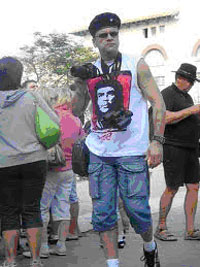
 |
Make Your Travel Plans Carefully |
 |
Babe - Watch Where You're
Swinging That Thing on the Bus! |
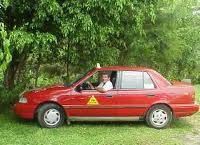 |
Taxi, Señor? |
 |
"Private" Taxi Señorita? |
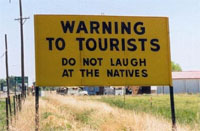 |
Might Be a Sign In the U.S. |
|
|
|
|
|---|
|
|---|
On the other hand, if you feel like you want to vary from any of these suggestions, then by all means do so as nobody really cares and we locals love a parade. However you decide to dress, act and behave, as long as it's within GAWS (Generally Accepted World Standards) you're OK with us. So enjoy your visit.
What's-in-a-Word Department
Mata Something
I'm always intrigued by the way language evolves and unusual words become incorporated into names proper and improper.
Take, for example, the verb "matar" in Spanish which means to kill, like in "Mata Guillermo" or "Kill Bill" (2003, Walt Disney Studios Miramax Division, Quentin Tarantino, Writer/Director. Oh my, deceased amigo Walt, your guys sure have come a long way from Mickey Mouse and Snow White and the Seven Dwarfs. Is that a groan from the grave I hear?)
Uma Thurman Getting Ready to Kill Bill
I Love a Woman With a Sword |
 |
Shortly before I moved to Costa Rica and long before my Spanish capability had risen to today's level of incompetency, a friend pointed out the meaning of "mata" by using Matamoros as an example. It means "kill the Moors". There are several towns named Matamoros in Mexico and also one in Ohio not far from Marietta, Ohio where I once lived (actually the town's full name is New Matamoras). I suspect there are a number of other places named Matamoros, including in Spain. I presume this name resulted from the rather harsh treatment the Iberian peninsula Spaniards received from invading hoards of Moors in the middle ages.
What brought up the renewed interest in this word was thinking about a town that goes by the name of Matapalo. Matapalo is situated some 20 kilometers south of Quepos on the coastal road. The first question I asked was: what's a "palo"? I learned later that the word cannot be separated and that matapalo refers to a type of killer vine that can strangle trees. I believe it. Hell, I'd believe almost anything someone would claim about that jungle out there. But why would a town name itself after a killer vine, rather than a flower or, more typically around here, a saint like San Gringo (just kidding) or an indian tribe like Quepos was named after? I guess more will be revealed later. (Local readers may feel they want to contribute here - CONTACT GG) |
They could have named the town Santiago ( St. James - GG recently became aware of the connection between this name and St. James the Apostle - MORE). So, I looked it up again and there turns out not only to be a connection between Santiago and St. James the Apostle but also a connection between St. James and matamoros. Go figure. I learned that St. James was often depicted in the middle ages, as he is in the painting to the right, as Santiago Matamoros or St. James 'the Moor Slayer'. Note in the picture that Jimmy is trampling a Moor. This is probably not a painting displayed in mosques around the world or in the Beirut town square.
Who was it that once said: "Search long and far enough and all knowledge comes around on itself" (actually, probably no one said that GG, your degenerate mind probably made it up)
The Moor slayer version came about as a legend. St. James (beheaded in 44 A.D. by Herod Agrippa) was called upon by some Spanish troops fighting the Moors in the Battle of Clavijo in Spain (844 A.D.). It was said that St. James miraculously appeared on horse and led the vastly outnumbered troops to victory. Kool legend, eh?
|
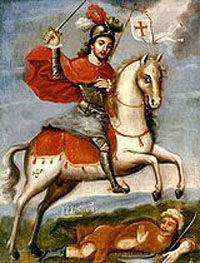
Santiago Matamoros
"St James the Moor Slayer" |
|
A quick search of other words beginning with "mata" yielded the following:
- matador (surprise, surprise, the bull dude is a "killer")
- matarratas (rat poison - which I presume goes into the Boca Raton - the rat's mouth)
- matasanos (or quack - latinos don't mince words about bad doctors do they?)
- matasellos (postmark - kill the letter?, c'mon that's a stretch)
- matasuegras (party killer - I guess gringos would say party "pooper", but that would probably have to be "mierdasuegras" in Spanish).
I can feel it again amigos, the mind wandering in this way. I feel like I can't stop, like I'm slipping, I'm falling ..... (and I don't even drink anymore)
R.O.M.E.O. Corner (Retired Old Men Eating Out)
Kapi Kapi (Manuel Antonio)
Location: Top of Manuel Antonio Hill, 50 Meters North of Victoria's Restaurant, Across the Street from Condominiums La Reserva
Hours/Parking: 4-10 PM, Dinner Only, Off-Street Parking
Contact: Telephone 2777-5049 ~ Email kapikapi@racsa.co.cr
In the language of the Maleku Indians of Costa Rica,
“Kapi Kapi” means welcome.
The three founding members of the Aguirre Chapter of the R.O.M.E.O. club decided at the last moment to go to Kapi Kapi over selecting a nearby restaurant for review (so many restaurants - so little time). GG and ROMEO Brian had been here once before and had an excellent meal. For ROMEO Paul, this was his first experience at Kapi Kapi. We all decided we were giving this dinner to ourselves as a present for Christmas.
The restaurant is situated on the land side of Manuel Antonio road and is set back a good 50 meters, putting it in the bosque (woods) and reducing road noise to a whisper even though the dining room open to the outside. In the evening, air conditioning is really not needed at the top of MA; we enjoyed a very pleasant temperature throughout the meal surrounded by trees and plants. The only cautionary note we made was that the walk from the parking area to the dining room involved a rather steep ramp and stairs that are not well lighted.
The dining room is warm, bathed in soft, orange-red tones and gently lighted indirectly with wall sconces. The tables are simple squares of dark wood, un-flowered and with no table cloth, just placemats. A small candle provided most of the lighting for reading menus and GG found the lighting a little dark for reading menus but ROMEO Brian assured me it was set at a romantic level (so who in our group is going to use it for that purpose?). The simplicity of the setting helps focus one's attention on the food, which, as it turned out, was outstanding.
We had no sooner sat down to table and been presented menus when our waiter began telling us about specials. While ROMEO Brian was mulling over the menu (he's good at that type of research) our server hit us with two things that neither ROMEO Paul nor I could resist. These were a ceviche appetizer made of pieces of rock shrimp and a fish with the texture of mahi mahi and a main course of medallions of Costa Rican lamb. I had thought, quite erroneously, that lamb is one thing not raised here as I never saw it in the markets. I also thought it was imported.
A contrario amigo, the waiter told me it comes from the San Carlos mountain region near San José. (That's the one thing about being located in the big city, you have access to all the goodies available) Both Paul and I signed up for the ceviche/lamb combination. |

|
ROMEO Brian selected a simpler meal of a green salad followed by a chicken dish. He was surprised that the chicken was a thigh/leg combination rather than a breast but reported that the dish was quite tasty.
The ceviche was as good as the waiter made it sound. It was presented very artfully in a dish decorated with "wings" of red cabbage leaves, patacone slices (I confess I don't yet see what Ticos see in these little slices of fluted plantain deep fried into a hard disk - I find them almost tasteless). The ceviche dish was crowned with a small disected crab. The taste was a bit picante and redolent of cilantro. The portion was very large and would have served as a good lunch on its own.
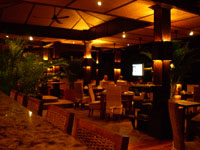
|
The lamb concoction was an outstanding concept. A lamb filet mignon is first marinated in coffee and Sambuca and then grilled to a crispy outside, medium rare inside. The marinade is reduced with red wine to a medium thick sauce and poured over thick slices of the filet. It's then served with a creamy rissoto containing finely diced onions and some other, apparently secret ingredient (there always has to be something secret in good recipes). Need I say yummers on the lamb?
The only thing that detracted from this meal and restaurant drawing five sloths was the fact that the lamb was inconsistent in tenderness. The pieces I had contained only two or three that were chewy, with the rest being tender. ROMEO Paul reported that a couple of pieces he had were sinewy and he could not swallow them. In a place like Kapi Kapi, all the pieces should be tender and free of gristle. Some day I hope the art of aging and trimming meat will be adopted in its fullest here, but evidently we haven't gotten there yet.
|
For desert, Brian chose rich vanilla ice cream with a chocolate sauce. I gathered it was good by the sounds of contentment eminating from his side of the table. Paul and I both chose the limone pie (sorta like key lime) which was splashed with mango pureé, drizzled lightly with chocolate and served with a generous dollop of freshly whipped cream. Double yummers on that one.
Nothing more needs be said. Kapi Kapi deserves four sloths out of five for ambiance, food quality and service. It's somewhat above average in price (the three course meal had by Paul and I cost $50 per plate) but still a great value for the offering. Four out of five $.
Travel Quote of the Month:
"Twenty years from now you will be more disappointed by the things that you didn't do than by the ones you did do. So throw off the bowlines. Sail away from the safe harbor. Catch the trade winds in your sails. Explore. Dream. Discover." - Mark Twain
Don Roberto de Quepos,
El Gringo Dorado
Pura Vida! |
|
|

